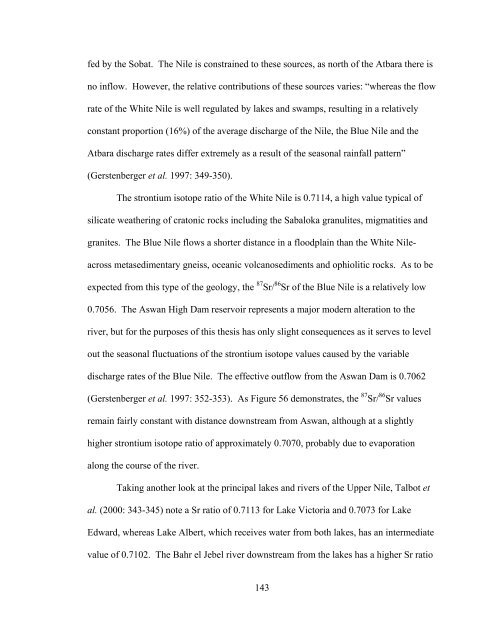Tracing the Source of the Elephant And Hippopotamus Ivory from ...
Tracing the Source of the Elephant And Hippopotamus Ivory from ...
Tracing the Source of the Elephant And Hippopotamus Ivory from ...
Create successful ePaper yourself
Turn your PDF publications into a flip-book with our unique Google optimized e-Paper software.
fed by <strong>the</strong> Sobat. The Nile is constrained to <strong>the</strong>se sources, as north <strong>of</strong> <strong>the</strong> Atbara <strong>the</strong>re is<br />
no inflow. However, <strong>the</strong> relative contributions <strong>of</strong> <strong>the</strong>se sources varies: “whereas <strong>the</strong> flow<br />
rate <strong>of</strong> <strong>the</strong> White Nile is well regulated by lakes and swamps, resulting in a relatively<br />
constant proportion (16%) <strong>of</strong> <strong>the</strong> average discharge <strong>of</strong> <strong>the</strong> Nile, <strong>the</strong> Blue Nile and <strong>the</strong><br />
Atbara discharge rates differ extremely as a result <strong>of</strong> <strong>the</strong> seasonal rainfall pattern”<br />
(Gerstenberger et al. 1997: 349-350).<br />
The strontium isotope ratio <strong>of</strong> <strong>the</strong> White Nile is 0.7114, a high value typical <strong>of</strong><br />
silicate wea<strong>the</strong>ring <strong>of</strong> cratonic rocks including <strong>the</strong> Sabaloka granulites, migmatities and<br />
granites. The Blue Nile flows a shorter distance in a floodplain than <strong>the</strong> White Nile-<br />
across metasedimentary gneiss, oceanic volcanosediments and ophiolitic rocks. As to be<br />
expected <strong>from</strong> this type <strong>of</strong> <strong>the</strong> geology, <strong>the</strong> 87 Sr/ 86 Sr <strong>of</strong> <strong>the</strong> Blue Nile is a relatively low<br />
0.7056. The Aswan High Dam reservoir represents a major modern alteration to <strong>the</strong><br />
river, but for <strong>the</strong> purposes <strong>of</strong> this <strong>the</strong>sis has only slight consequences as it serves to level<br />
out <strong>the</strong> seasonal fluctuations <strong>of</strong> <strong>the</strong> strontium isotope values caused by <strong>the</strong> variable<br />
discharge rates <strong>of</strong> <strong>the</strong> Blue Nile. The effective outflow <strong>from</strong> <strong>the</strong> Aswan Dam is 0.7062<br />
(Gerstenberger et al. 1997: 352-353). As Figure 56 demonstrates, <strong>the</strong> 87 Sr/ 86 Sr values<br />
remain fairly constant with distance downstream <strong>from</strong> Aswan, although at a slightly<br />
higher strontium isotope ratio <strong>of</strong> approximately 0.7070, probably due to evaporation<br />
along <strong>the</strong> course <strong>of</strong> <strong>the</strong> river.<br />
Taking ano<strong>the</strong>r look at <strong>the</strong> principal lakes and rivers <strong>of</strong> <strong>the</strong> Upper Nile, Talbot et<br />
al. (2000: 343-345) note a Sr ratio <strong>of</strong> 0.7113 for Lake Victoria and 0.7073 for Lake<br />
Edward, whereas Lake Albert, which receives water <strong>from</strong> both lakes, has an intermediate<br />
value <strong>of</strong> 0.7102. The Bahr el Jebel river downstream <strong>from</strong> <strong>the</strong> lakes has a higher Sr ratio<br />
143

















